The prostate is a gland that only men have and is located below the bladder and surrounds the urethra. Its main task is to produce seminal fluid, an integral part of male sperm. It is a small gland that can become a big problem. The prostate can become enlarged due to aging or diseases such as benign prostatic hyperplasia and prostatitis. An enlarged prostate often causes difficulty urinating and sexual issues.
PROSTATE: What is it, and where is it? | Prostate Tasks | Prostate problems | Symptoms | Diseases of the prostate | Questions and Answers | Sources/references
What is the prostate, and where is it located?
The prostate is a small gland about the size of a table tennis ball located deep in the groin, between the base of the penis and the rectum. It is essential for human reproduction, as it supplies part of the seminal fluid (semen) that mixes with sperm from the testicles. The seminal fluid helps the sperm to travel and survive.
The seminal vesicles are rabbit-eared structures on top of the prostate that store and secrete much of the ejaculate. The neurovascular bundle is a collection of nerves and blood vessels that run along both sides of the prostate and help control erectile function. In some men, these nerves run a short distance from the prostate; in others, they attach to the prostate itself. Their exact location does not affect the prostate function or contribute to prostate cancer once it occurs.
Image: An image of the prostate surrounding the urethra.
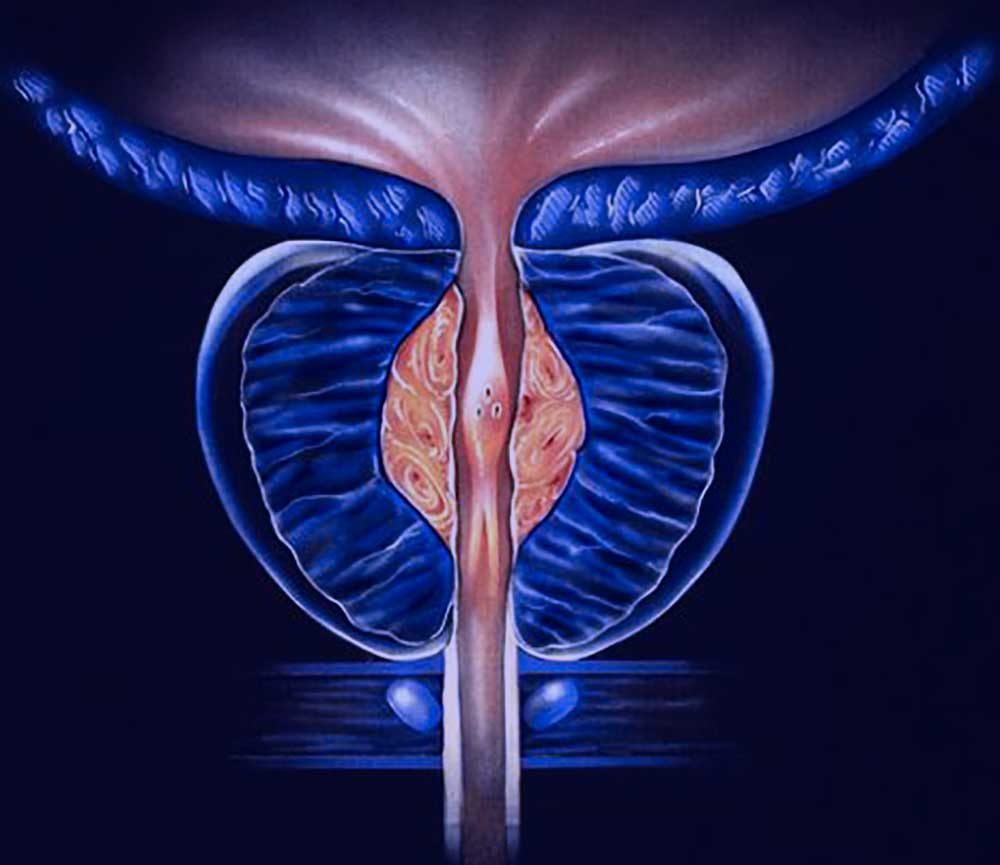
The bladder is like a balloon that gets bigger as it fills with urine. The urethra, a narrow tube that connects to the bladder, runs through the middle of the prostate and along the penis, carrying urine and semen out of the body. The rectum, located just behind the prostate, is the lower part of the intestine and connects to the anus.
The prostate is divided into several anatomical regions or zones. However, most prostate cancer starts in the peripheral area (the back of the prostate) near the rectum. That's why a digital rectal exam (DRE), in which a doctor examines the prostate by inserting a gloved finger into the rectum, is a standard and valuable screening test in addition to the PSA blood test.
The more you know about the prostate, its normal development and function, and where it is located. What it is attached to, the better you will understand how prostate cancer develops and affects a person's life over time - either as a result of the cancer growing or as a result of treatments.
What tasks does the prostate perform?
The prostate is not necessary for life but is essential for reproduction. Healthy sperm can only survive if the seminal fluid is of perfect consistency and represents a quality environment for the passage and survival of sperm. Among other things, semen also includes antigens such as PSA (which is measured very often and is, among other things, important information in screening tests that determine the probability of prostate cancer), as well as other substances secreted by the seminal vesicles and the prostate, such as they are zinc, citrate, and fructose (which give the sperm energy to travel to the egg). The seed also contains substances that protect the urinary tract and sperm from bacteria and other pathogens.
Video content: what is the prostate, and what are its roles?

The prostate grows typically during adolescence under the control of the male hormone testosterone and its byproduct, dihydrotestosterone (DHT). Testosterone is mainly produced in the testicles, but a smaller amount is also produced in the adrenal glands above the kidneys.
Prostate problems most often start to appear after the age of 60
Prostate enlargement rarely causes signs and symptoms in men under 40. About one-third of men experience moderate to severe symptoms by age 60, and nearly half by age 80.
For most men, the prostate continues to grow throughout their lives. In many men, this continued growth enlarges the prostate enough to cause urinary symptoms or severely block urine flow. It is not entirely clear what causes prostate enlargement, but it may be due to changes in the balance of sex hormones as men grow older.
Symptoms of prostate problems
In its earliest stages, the prostate disease may or may not be associated with symptoms.
Video content: Enlarged prostate - signs and symptoms.

Symptoms of prostate disease depend on the condition but may include:
- urination problems
- inclination to urinate frequently, especially at night
- feeling as if the bladder cannot be completely emptied
- painful urination
- blood in the urine or blood from the urethra, independent of urination.
Blood in the urine is often due to causes unrelated to the prostate. Always see a doctor if you find blood in your urine.
The most common forms of prostate disease and symptoms
Here are some examples of non-cancerous prostate problems:
Benign prostatic hyperplasia or BPH
This is a widespread prostate problem, mainly affecting older men.
Image: A comparison of a normal prostate and an enlarged prostate, a common health problem in men.
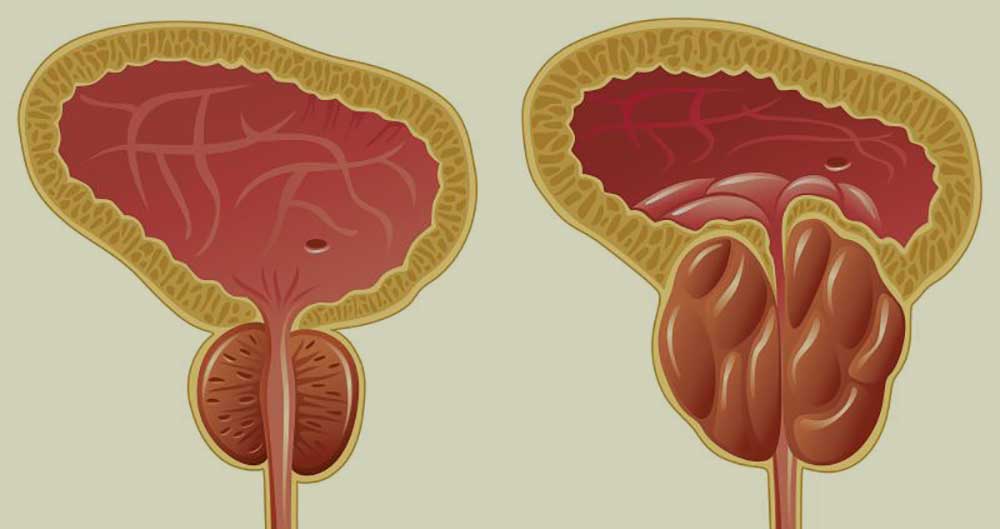
This means that your prostate is enlarged but not cancerous.
BPH treatment includes:
Active monitoring: if your symptoms are not alarming, your doctor may tell you to wait to see if your symptoms get worse before starting treatment. Your doctor will explain how often you should return for check-ups.
Medications: Medications can help shrink the prostate or relax the muscles near the prostate to relieve symptoms.
Surgery: if nothing else helps, your doctor may suggest surgery to help your urine flow.
Other treatments: radio waves, microwaves, or lasers are sometimes used to treat urination problems caused by BPH. These methods use different types of heat energy to reduce excess prostate tissue.
Acute bacterial prostatitis
This usually starts suddenly due to a bacterial infection.
Video content: Prostatin (inflammation of the prostate) and various known types

See your doctor immediately if you have fever, chills, or pain in addition to your prostate symptoms. Most cases can be cured with antibiotics. However, you may also need medication to relieve pain or discomfort.
Chronic bacterial prostatitis
It is an infection that keeps coming back. This rare problem is challenging to treat. Sometimes taking antibiotics for a long time can help solve the problem. Talk to your doctor about other things you can do to help you feel better.
Chronic prostatitis
Also called chronic pelvic pain syndrome, it is a common problem with the prostate. It can cause pain in the lower back, groin, or at the tip of the penis. Treatment may require a combination of medications, surgery, and lifestyle changes.
Prostate cancer and diagnosis
Prostate cancer usually affects men over the age of 50. The cause remains unknown, although age and family history are known to contribute to morbidity. In the early stages, cancer cells are confined to the prostate. In more aggressive types of prostate cancer, cancer cells enter the vascular and lymphatic system early and spread to other body parts, where they develop secondary tumors, especially in the bones.
Image: showing prostate cancer.
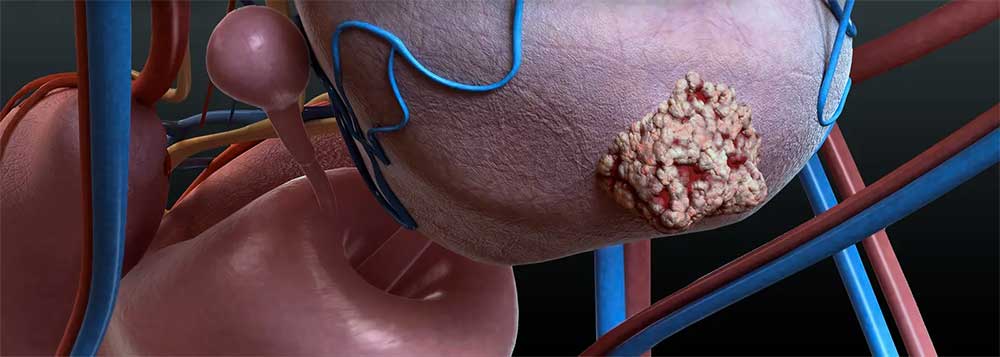
Morbidity factors for prostate cancer:
- Age: men aged 50 and over are at greater risk.
- Family history: if your father or brother had prostate cancer, you are more likely to get it too.
- Diet: The risk of prostate cancer may be higher in men who eat a diet high in fat.
To determine whether your prostate symptoms are due to cancer, your doctor will ask about your past health problems and your family's medical history.
Video content: symptoms in the diagnosis of prostate cancer.

Your doctor will also perform a physical examination. During the study, the doctor will examine your prostate with a gloved finger in your rectum and check the following:
- Size, firmness, and texture of the prostate.
- Any problematic areas, lumps, or growths that extend outside the prostate.
- Any pain caused by touch or pressure on the prostate.
You may need to provide a urine sample for testing purposes. Your doctor may also do a blood test to check your prostate-specific antigen (PSA) level. PSA levels may be high in men with an enlarged prostate or prostate cancer. You may also need an ultrasound scan, which takes a computerized image of the prostate.
If the tests show that you might have cancer, your doctor will refer you to a specialist (urologist) for a prostate biopsy (removal of prostate tissue). The doctor will take small samples of tissue from several areas of the prostate to look for possible cancer cells.
Questions and answers
How do I keep my prostate health and in perfect condition?
Here are eight helpful tips for optimal prostate health:
- First, maintain a healthy weight that suits your constitution. Excess is often associated with many health problems, and the likelihood of prostate cancer also increases.
- Enjoy and eat vegetables more often.
- Excessive consumption of red meat is not recommended
- Do regular physical activity, and speed up the rhythm of your heart.
- Stress is your enemy; tame it.
- Quit smoking
- Drink sufficient amounts of water
How can you strengthen the prostate yourself?
It is a common fact that exercise that is good for heart health is also good for the health of the male prostate and your sexual health. We, therefore, recommend that you perform up to 30 minutes of active physical exercise in the form of running, swimming, cycling, brisk walking, or hiking.
For the intensity of the exercises to be perfect, add weights as a training method - you can also use fitness equipment.
Why is the prostate important for a man?
The prostate is located just below the bladder and in the area in front of the rectum. The prostate is the size of a medium-sized walnut and anatomically surrounds the urethra - the tube through which the bladder empties when it is complete. The primary meaning and purpose of the prostate is the production of seminal fluid, which allows sperm to travel and survive.
Aging is the main negative factor that causes the enlargement of the prostate itself, consequently reducing the urethra itself, resulting in significantly more difficult urination in men.
Which diet cleanses and has a beneficial effect on the prostate?
Let's list the five best foods for a healthy prostate:
- Brussels - this class of vegetables includes cabbage, kale, cauliflower, and Brussels sprouts. ...
- Strawberries. ...
- Fish. ...
Video Content: Important Nutrients That Shrink An Enlarged Prostate.

- Cooked tomatoes. ...
- Coffee and tea.
What problem does removal of the prostate pose for men?
Particularly erectile dysfunction is a significant problem after radical prostatectomy, which is a consequence of the development of prostate cancer. However, the story of more modern methods for removing and operating the prostate makes it possible to restore an erection in a shorter time after invasive prostate surgery.
Can an enlarged prostate return to normal?
Can an enlarged prostate be cured? For most patients, an enlarged prostate is treatable. Modern drugs often solve the problem of an enlarged prostate, so visiting a personal doctor is the right decision. Your doctor can refer you further to a specialist[1].
If you notice that the prescribed medicine does not help you, a joint decision is an invasive surgical intervention performed with the help of sophisticated operative techniques.
Which diet will reduce an enlarged prostate?
A low-fat diet is in order. We recommend a diet that is enriched with a variety of different types of vegetables. Eat a serving daily, and don't forget to include citrus fruits enriched with plenty of vitamin C in your regular diet. Don't forget about regular exercise.
Enlarged prostate - how to help without surgery?
The options are as follows:
- Alpha-blockers. These drugs relax the bladder, neck muscles, and muscle fibers in the prostate, which significantly facilitates urination.
- 5-alpha reductase inhibitors. These drugs shrink your prostate by preventing the hormonal changes that cause the prostate to grow.
- Combined treatment.
- Tadalafil (Cialis).
At what age does the prostate usually swell?
From age 25 onwards, the prostate in men begins to increase slowly. The condition is called benign prostatic hyperplasia (BPH) and has no relation to cancer. Unfortunately, the cause of prostate enlargement is unknown.
What does a swollen prostate feel like?
The feeling of a swollen prostate is often unpleasant; the most significant complication is the burning sensation when urinating and the burning sensation that accompanies urination. Difficulty urinating, such as dribbling or hesitancy, is a common problem, as is frequent urination, especially at night (nocturia).[2].
Can an enlarged prostate affect bowel movements?
In some rare cases, an enlarged prostate can affect bowel movements, but this condition is not shared. This is because the prostate lies below the bladder, just in front of the lower part of the rectum. Because they are so close to each other, it is not uncommon for an enlarged prostate to affect peristalsis[3].
Sources and references
1. ENLARGED PROSTATE / BENIGN PROSTATIC HYPERPLASIA (BPH) - https://healthcare.utah.edu
2. Symptoms - Benign prostate enlargement - https://www.nhs.uk
3. Benign prostatic hyperplasia (BPH) - https://www.mayoclinic.org/





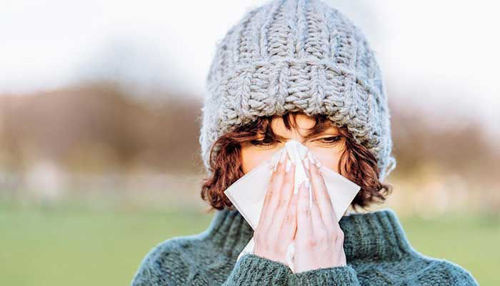
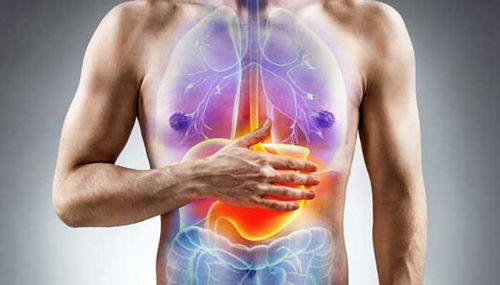

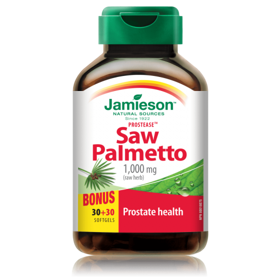

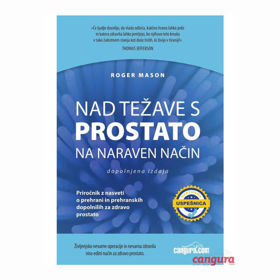

 Facebook
Facebook
 Instagram
Instagram
 info@moja-lekarna.com
info@moja-lekarna.com

